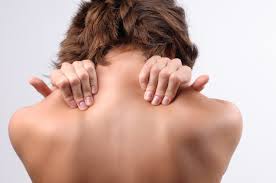 Pain in the upper back can arise following an injury. Upper back pain can also result from misalignment, which typically stems from postural problems. One major cause of the pain is office work, which – especially in the absence of lumbar supports and an ergonomic setup – requires the back to be held in a compromised position. Unnatural and prolonged use of the arms for typing and other activities can add to the strain and discomfort over time as well. Pain in the upper back is often accompanied by pain in the neck and shoulders.
Pain in the upper back can arise following an injury. Upper back pain can also result from misalignment, which typically stems from postural problems. One major cause of the pain is office work, which – especially in the absence of lumbar supports and an ergonomic setup – requires the back to be held in a compromised position. Unnatural and prolonged use of the arms for typing and other activities can add to the strain and discomfort over time as well. Pain in the upper back is often accompanied by pain in the neck and shoulders.
Physiologically, upper back pain is rooted primarily in two health conditions:
- irritation of the tissues, resulting in myofascial pain; and
- damage to the joints.
How muscular irritation relates to upper back and neck pain
The girdle of the shoulder connects to the rib cage and scapula by extensive bands of muscle. The muscles of the upper back can easily become irritated, generating substantial myofascial pain. This muscular disorder is often the result of weakness or repetitive strain – the same issue behind tendinitis and carpal tunnel syndrome – as is often experienced by those with desk jobs.
Typically this form of back pain is treated with techniques aimed at loosening and strengthening the musculature. Within physical therapy, relevant methods include stretches and exercises. Additional therapies may include such treatments as spinal decompression, cold laser therapy, and natural supplemental injections.
How joint damage relates to upper back and neck pain
The ribs attached to the spine via a pair of joints. If the joints are not functioning properly, pain can result.
Treatment often involves chiropractic adjustment to allow the joints to move freely, alleviating the pain. As with treatment for myofascial pain, stretches and strength-training exercises are usually recommended. Cardiovascular activities – such as biking, running, and swimming – can also help to heal the back by delivering plentiful oxygen to that region of the body.
Pharmaceutical drugs, especially ones designed to reduce inflammation, are sometimes prescribed to alleviate pain. Injections may also be used at trigger points, bundles of tight tissues that refer pain to the upper back.
Comprehensive solutions for upper back pain
The most effective way to treat pain in the upper back is to work with a multidisciplinary pain management practice. Using diverse techniques that draw on the expertise of numerous specialists, multidisciplinary teams use the latest innovations from a variety of fields. Contact Atlanta Medical Clinic today for a free consultation.
